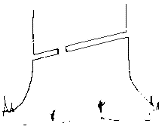Logging eTool
The Back Cut » Incorrect Backcutting

When using a felling method with a horizontal facecut, the OSHA standard requires that the backcut be made above the level of the horizontal facecut. This will create a step to keep the tree from sliding back across the stump. [29 CFR 1910.266(h)(2)(vii)]
Kinds of Incorrect Back Cuts:
Back cut at the same level as a horizontal facecut

Highly increases the possibility of the tree butt kicking-back off the stump and decreases elasticity of the hinge.
Back cut too deep

The hinge will break almost immediately resulting in inaccurate felling, and possible damage to the bar or saw.
Back cut too high above the notch

Highly increases the necessity of pushing or pulling the tree to make it fall; produces low quality butt and also decreases the effectiveness of the notch.
Back cut below the notch

Highly increases the possibility of the tree sitting back on the stump; produces a low quality butt and also may require pushing.
Sloping back cut

Lessens the effectiveness of the hinge or leaves an inaccurate hinge, producing a low quality butt and wasted material.
Angle back cut with inadequate notch

Increased possibility of barber chairing, hinge breaks early, resulting in loss of felling control and a low quality butt.
![]() Additional Information:
Additional Information:
-
Logging Operations, Inspection Procedures and Interpretive Guidance Including Twelve Previously Stayed Provisions. OSHA Directive CPL 02-01-022 [CPL 2-1.22], (September 27, 1996). [See Paragraph (h) Tree Harvesting: Paragraph (h)(2)(vii) - Backcuts]
Additional information on Incorrect Backcutting.

